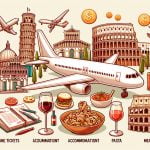Italy, with its rich history, exquisite cuisine, and breathtaking landscapes, has long been a dream destination for travelers around the world. But before you embark on your Italian adventure, it’s important to consider the all-important question: How much money is it to travel to Italy? In this article, we will delve into the various aspects of planning a trip to Italy and provide valuable insights to help you budget effectively.
Italy possesses an undeniable allure that captivates visitors from every corner of the globe. From the iconic historical landmarks of Rome and Florence to the picturesque canals of Venice and the charming coastal villages of Cinque Terre, each region offers its own unique appeal. However, exploring this European gem comes with a price tag attached.
In the following sections, we will break down the costs associated with traveling to Italy. We will explore everything from airfare variations based on departure location and season to comparing different accommodation options that suit various budgets. Additionally, we will discuss average prices for daily expenses such as food, transportation, and activities. Alongside these essential tips for expense management, we will also reveal insider hacks for navigating Italy on a shoestring budget and discovering hidden gems off the beaten path.
So whether you’re dreaming of strolling through ancient ruins in Rome or savoring perfect bites of pizza in Naples, join us as we explore how much money it really takes to travel to Italy. With careful planning and resourcefulness, you can make your Italian getaway both affordable and unforgettable. Let’s dive in.
The Cost of Flights to Italy
Planning a trip to Italy begins with finding affordable flights. The cost of flights to Italy can vary greatly depending on your departure location and the time of year you plan to travel. By considering these factors and utilizing some savvy travel strategies, you can save money on airfare and make the most of your budget.
When it comes to booking flights to Italy, it’s important to be flexible with your travel dates. Prices tend to be higher during peak tourist seasons, such as summer or around major holidays. Consider traveling during shoulder seasons, like spring or fall, when prices are generally lower. Additionally, being open to flying on weekdays instead of weekends can often result in significant savings.
Another key factor in determining flight costs is your departure location. Major international airports typically offer more direct routes and competitive prices compared to smaller regional airports. If you live near several airports, compare prices from each one before booking your flight. It may be worth driving a bit farther if it means saving money on airfare.
To find budget-friendly flights, consider utilizing travel rewards and loyalty programs. Many airlines offer credit cards that earn frequent flyer miles or points that can be redeemed for discounted or even free flights. Keep an eye out for special promotions and flash sales as well; subscribing to airline newsletters or following them on social media can help you stay informed about these offers.
When searching for flights online, use search engines and aggregator websites that allow you to compare prices across different airlines and travel agencies. Be sure to clear your cookies or use private browsing mode while searching, as websites often track user behavior and show higher prices for repeated searches.
Accommodation Options
Italy offers a wide range of accommodation options to suit every budget. From luxury hotels to budget-friendly hostels and vacation rentals, travelers can find the perfect place to stay during their visit. The average prices for accommodations vary depending on the region and city in Italy.
In popular tourist destinations like Rome, Florence, and Venice, luxury hotels can come with a hefty price tag. On average, a night at a five-star hotel in Rome can cost around $300 to $500 USD. However, for those on a tighter budget, there are plenty of affordable alternatives available. Budget-friendly hostels and guesthouses can be found throughout Italy, with prices ranging from $20 to $100 USD per night.
For travelers looking for a more authentic experience, renting an apartment or staying in an agriturismo (a farmstay) can be great options. These types of accommodations not only offer more space but also provide an opportunity to immerse oneself in the local culture. Prices for vacation rentals vary depending on the location and size of the property but can start at around $100 USD per night.
| Accommodation Type | Average Price per Night |
|---|---|
| Five-star hotel | $300 – $500 |
| Budget-friendly hostel | $20 – $100 |
| Vacation rental/apartment | $100+ |
| Agriturismo/farmstay | $100+ |
Regardless of the budget, it is important to book accommodations in advance, especially during peak travel seasons. Additionally, it’s advisable to check for any additional fees or taxes that may not be included in the initial price. With careful planning and research, travelers can find affordable stays in Italy that suit their preferences and allow them to fully enjoy their Italian adventure.
Daily Expenses
Italy is known for its delicious cuisine, efficient transportation system, and a myriad of activities and attractions for all types of travelers. However, it’s important to budget accordingly for daily expenses to make the most out of your trip. In this section, we will break down the average costs of meals and dining experiences in Italy, explore public transportation options and their associated prices, and detail the cost of popular tourist activities and attractions.
When it comes to food in Italy, you can find a diverse range of options to suit any budget. From gourmet restaurants to local pizzerias and street food stalls, there is something for everyone.
On average, a meal at a mid-range restaurant can cost around €12-€20 per person, while a quick slice of pizza or sandwich from a local shop may only set you back €3-€5. Additionally, exploring local markets and grocery stores offers an excellent opportunity to indulge in fresh produce and ingredients at more affordable prices.
Public transportation in Italy is well-developed, making it easy to navigate cities and travel between regions. The cost of transportation varies depending on the city or town you are visiting. For example, a single ticket for public transport within Rome or Milan usually costs around €1-€2.50 per ride. If you plan on using public transport frequently during your stay, consider purchasing day passes or multi-day tickets that offer unlimited rides within a specific timeframe.
Italy is home to countless iconic tourist attractions that come with varying entrance fees. For instance, visiting the Colosseum in Rome can cost around €16 per person while exploring the Vatican Museums carries an admission fee of approximately €17-€27 depending on whether you opt for skip-the-line tickets or guided tours.
Keep in mind that many popular attractions offer discounts for students or seniors. It’s also worth noting that several historical sites can be visited free-of-charge including St. Peter’s Basilica in Vatican City.
By budgeting for food, transportation, and activities, you can plan your daily expenses accordingly. It’s always a good idea to research and compare prices beforehand, as well as taking advantage of any available discounts or deals. With proper planning and smart choices, you can enjoy the incredible experiences Italy has to offer without breaking the bank.
Navigating Italy on a Shoestring Budget
Italy is a dream destination for many travelers, but the cost of exploring this European gem can sometimes be overwhelming. However, with some savvy planning and money-saving travel hacks, it is possible to experience the beauty of Italy without breaking the bank. In this section, we will share insider tips and tricks to help you make your trip more affordable and reveal budget-friendly alternatives to commonly expensive experiences.
One of the biggest expenses when traveling to Italy is accommodation. While luxury hotels may offer comfort and convenience, they often come with a high price tag. To save money on lodging, consider alternative options such as budget-friendly hostels or even apartment rentals through platforms like Airbnb. Not only can these options be significantly cheaper than traditional hotels, but they also provide unique opportunities to experience Italy like a local.
When it comes to dining in Italy, eating at restaurants every day can quickly add up. Instead, take advantage of the country’s vibrant street food culture. Grabbing a slice of pizza from a local pizzeria or indulging in gelato from a gelateria can not only be delicious but also much more affordable than sitting down for a full meal at a restaurant. Additionally, exploring local markets and grocery stores can save you money on snacks and picnic foods.
Public transportation in Italy is well-developed and offers an affordable way to get around. Instead of relying solely on taxis or private transfers, use the extensive network of trains and buses to explore different cities and regions within the country. Booking train tickets in advance or purchasing multi-day passes can provide additional savings.
As for activities and attractions, keep in mind that some of the most popular tourist spots in Italy often come with hefty entrance fees. However, there are usually free or low-cost alternatives nearby that offer similar experiences. For example, instead of visiting famous museums or landmarks that charge high admission fees, consider exploring lesser-known sites or attending local festivals and events.
| Travel Hack | Description |
|---|---|
| Consider alternative accommodations | Choose budget-friendly hostels or apartment rentals instead of luxury hotels |
| Explore street food culture | Save money by indulging in delicious and affordable street snacks like pizza and gelato |
| Utilize public transportation | Making use of trains and buses can be a cost-effective way to get around Italy |
| Find free or low-cost alternatives to popular attractions | Instead of expensive museums, seek out lesser-known sites or attend local events |
By implementing these money-saving travel hacks, you can stretch your budget while still enjoying all that Italy has to offer. It’s time to start planning your own unforgettable Italian adventure without breaking the bank.
Hidden Gems
Italy is known for its iconic cities like Rome, Florence, and Venice, but there are also hidden gems scattered throughout the country that offer great value for money. These lesser-known destinations provide a unique and authentic Italian experience without the crowds and high prices typically associated with popular tourist hotspots.
One such hidden gem is Bergamo, a city located in the Lombardy region of Italy. This charming medieval town is divided into two parts: Città Alta (Upper Town) and Città Bassa (Lower Town). Città Alta is perched on top of a hill and is surrounded by ancient Venetian walls.
Visitors can explore narrow cobblestone streets, visit historic sites such as the Basilica of Santa Maria Maggiore, and enjoy breathtaking panoramic views of the surrounding countryside. In Città Bassa, visitors can shop at stylish boutiques, dine at local trattorias, and immerse themselves in the vibrant local culture.
Another hidden gem in Italy is Matera, located in the southern region of Basilicata. This ancient city is famous for its unique cave dwellings known as “sassi.” These caves were once homes carved into the rock and have now been transformed into hotels, restaurants, and shops. Visitors to Matera can take guided tours to learn about the history and significance of these cave dwellings or simply wander through the maze-like streets to discover hidden churches and breathtaking views.
When traveling off the beaten path in Italy, it’s important to consider transportation options. While major cities are well-connected by trains and buses, getting to more remote areas may require renting a car. However, this can be an opportunity to explore scenic routes and picturesque landscapes that wouldn’t be accessible by public transportation.
Exploring Italy’s hidden gems not only provides excellent value for money but also allows travelers to experience a side of Italy that many tourists miss out on. From charming medieval towns to ancient cave dwellings, these off-the-beaten-path destinations offer a unique glimpse into Italy’s rich history and culture. So, consider venturing beyond the well-trodden tourist paths on your next Italian adventure and discover the hidden gems that make this country so special.
Planning for Unexpected Expenses
Traveling to any destination requires careful planning and budgeting, and Italy is no exception. In this section, we will discuss some of the unexpected expenses that you should consider when planning your trip to Italy. From health and insurance costs to miscellaneous fees, being prepared for these expenses will ensure a smooth and stress-free vacation.
Healthcare Access and Potential Additional Expenses
It is essential to consider healthcare access while traveling in Italy. While Italy has a well-developed healthcare system, visitors are advised to have travel insurance that covers medical emergencies. In case of any unforeseen circumstances, having travel insurance will give you peace of mind knowing that you are financially protected in case of medical expenses.
Additionally, it is wise to have a basic understanding of the local healthcare system. It’s a good idea to carry a list of emergency phone numbers with you at all times so that you can quickly reach out for assistance if needed. Furthermore, it is recommended to consult with your primary healthcare provider before traveling to Italy about any necessary vaccinations or precautions specific to your health condition.
Travel Insurance Options and Costs
When considering travel insurance for your trip to Italy, make sure to choose a plan that suits your needs. Most travel insurance policies cover medical emergencies, trip cancellations or interruptions, lost baggage or personal belongings, and even emergency evacuation if required.
The cost of travel insurance varies based on several factors such as the duration of your stay, age, pre-existing conditions, and the level of coverage you opt for. It is advisable not to solely rely on the minimum coverage provided by credit card companies or airlines as they might have limitations or exclusions.
In order to find the best deal on travel insurance premiums, compare quotes from different providers and carefully read through the policy details. Remember that while purchasing travel insurance may seem like an additional expense upfront, it can save you significant money in case of unexpected situations during your trip.
Miscellaneous Costs and Fees
When budgeting for your trip to Italy, it is crucial to consider any miscellaneous costs and fees that may arise. These can vary depending on your travel style and preferences, but be sure to account for these potential expenses:
- Visa fees: Depending on your nationality, you may need a visa to enter Italy. Research the visa requirements and associated fees well in advance of your departure date.
- Tipping: Tipping practices in Italy differ from those in other countries. While not obligatory, leaving a small tip, especially for excellent service at restaurants or hotel staff, is appreciated. Additionally, some public restrooms may require a small fee for use.
- ATM withdrawal fees: If you plan on using cash during your trip, be aware of any ATM withdrawal fees charged by both the local bank and your home bank. It might be more cost-effective to withdraw larger sums less frequently rather than multiple smaller withdrawals.
By considering these unexpected expenses and planning accordingly, you can ensure that you have a worry-free vacation experience in Italy without breaking the bank.
Budgeting for Souvenirs
When traveling to Italy, it’s natural to want to bring back souvenirs that will remind you of your amazing trip. However, buying souvenirs can quickly add up and strain your budget.
That’s why it’s important to plan ahead and find unique Italian mementos that are within reach without breaking the bank. In this section, we will explore some affordable and distinctive souvenirs to bring back home, as well as local markets and shops where budget-friendly keepsakes can be found.
Affordable and Distinctive Souvenirs
Italy is known for its rich culture and craftsmanship, so there are plenty of unique souvenirs that won’t cost a fortune. One popular option is picking up a piece of Murano glass from the island of Murano near Venice. These handcrafted glass items, such as jewelry or decorative figurines, make for beautiful gifts and are available at various price points.
Another affordable souvenir option is traditional Italian ceramics, which can be found in many regions across the country. Whether you choose a small ornamental piece or a colorful plate, these ceramics add a touch of Italy to your home without breaking the bank.
Local Markets and Shops
Exploring local markets and shops is not only a great way to immerse yourself in the authentic Italian experience but also an opportunity to find budget-friendly souvenirs. For example, if you happen to visit Florence during your trip, don’t miss the San Lorenzo Market. Here you can find leather goods such as bags, belts, and wallets at competitive prices.
Rome also offers numerous street markets like Porta Portese where you can hunt for bargains on clothing, accessories, antiques, and more. Additionally, boutique shops in smaller cities like Bologna or Lecce often have unique handmade items by local artisans at reasonable prices.
By planning ahead and exploring these options for affordable souvenirs, you can find mementos that are not only budget-friendly but also hold a special meaning from your time in Italy. Remember, the true value of a souvenir lies in the memories it represents, so don’t be afraid to step off the beaten path and seek out hidden gems when looking for that perfect Italian keepsake.
Conclusion
Italy is a country known for its rich history, breathtaking landscapes, and delicious cuisine. Although the cost of traveling to Italy may seem daunting at first, the experience is truly priceless.
Throughout this article, we have explored various aspects of planning a trip to Italy on a budget, from finding affordable flights and accommodations to navigating daily expenses and exploring hidden gems. Now, as we reach the conclusion of our journey, it is important to reflect on the value of visiting Italy.
While it is true that traveling can require financial investment, the memories and experiences gained from a trip to Italy are truly invaluable. From walking through ancient Roman ruins in Rome to cruising along narrow canals in Venice or indulging in authentic Italian gelato in Florence, each moment spent in this beautiful country will leave an indelible mark on your heart. The architecture, art, culture, and gastronomy that Italy has to offer are unrivaled, making it worth every penny spent.
Additionally, exploring Italy on a budget does not mean sacrificing quality or missing out on must-see attractions. This article has provided numerous money-saving travel hacks and highlighted hidden gems off the beaten path where travelers can experience the true essence of Italy without breaking the bank. From charming coastal towns like Cinque Terre to lesser-known regions like Puglia or Emilia-Romagna, there are countless opportunities to explore lesser-known destinations that offer great value for money.
As you embark on planning your own budget-friendly Italian adventure, remember that there are endless ways to make your trip more affordable. Utilizing travel rewards programs and being flexible with your travel dates can help significantly lower airfare costs.
Opting for budget-friendly accommodations such as hostels or vacation rentals can save you money without compromising comfort. And by dining at local trattorias and osterias rather than touristy restaurants, you can enjoy delicious Italian cuisine at a fraction of the price.
In conclusion, the allure and beauty of Italy are worth every dollar spent. By carefully planning and budgeting, it is possible to have an unforgettable experience in this European gem without breaking the bank. The memories, experiences, and cultural enrichment gained from a trip to Italy are truly priceless, making it a destination that should be on everyone’s travel bucket list.
So start planning your own Italian adventure and get ready to create memories that will last a lifetime. Buon viaggio.
Frequently Asked Questions
How expensive is it to travel to Italy?
The cost of traveling to Italy can vary depending on various factors such as the season, accommodation choices, transportation options, and personal preferences. Overall, Italy can be considered a relatively expensive destination compared to some other European countries. Cities like Rome, Florence, and Venice are popular tourist spots with higher prices for accommodations, meals, and attractions.
On average, travelers can expect to spend around $100-150 per day on basic expenses like meals and transportation. However, this estimate does not include additional costs for activities, shopping, or upscale dining experiences.
How much is a trip to Italy for 1 week?
Planning a trip to Italy for one week involves considering several factors that could influence the total cost. The expenses will heavily depend on individual choices related to accommodations, dining preferences, activities planned, and transportation modes used within the country.
On average, a budget traveler may spend around $800-$1200 for a week-long stay in Italy excluding airfare costs. This estimate includes basic expenses like accommodation in mid-range hotels or vacation rentals outside major cities while opting for local trattorias or casual restaurants for meals.
How much does it cost to go to Italy for 10 days?
The cost of going to Italy for 10 days will primarily depend on personal travel preferences and spending habits during the trip. With an increased duration of stay comes more opportunities to explore different regions and cities in Italy. The budget should consider not only accommodation costs but also potentially higher expenditure on activities and transportation between destinations when compared to shorter visits.
On an average basis, one can expect to spend around $1500-$2500 excluding airfare costs during a ten-day trip to Italy. This estimate allows for more flexibility in selecting comfortable accommodations and experiencing a variety of cuisine options while accounting for day trips or tours within specific regions of interest.

I’m a passionate traveler, writer, and Italophile. My fascination with Italy’s history, art, and culture has led me on countless adventures across the Italian landscape. Through “I Live Italy,” I share my love for this extraordinary country and aims to inspire others to explore its boundless beauty.





